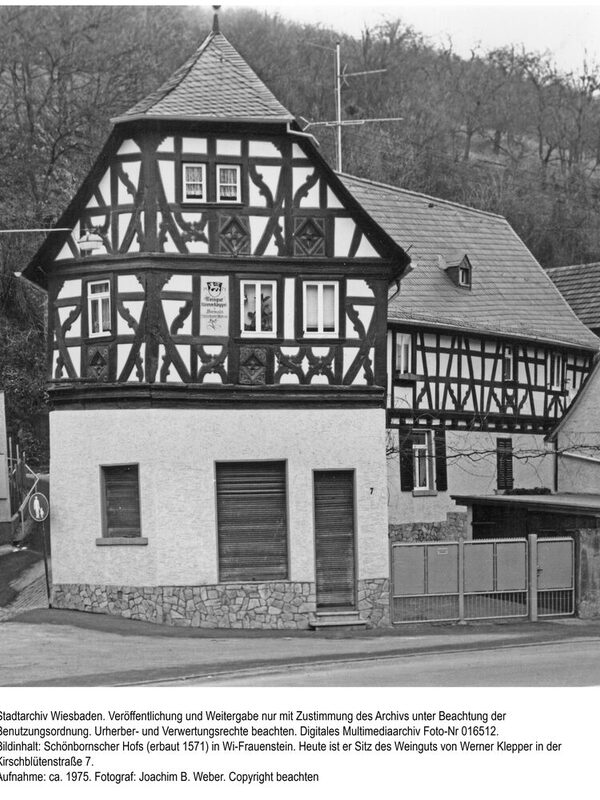Frauenstein
The origins of Frauenstein are closely linked to the castle of the same name, which its owners, the Knights of Frauenstein, sold to the Archbishop of Mainz around 1300. Frauenstein is likely to have developed as a settlement for the castle garrison. In 1319, the inhabitants are referred to as "people in the valley". Administratively, the village belonged to the Schiersteiner Mark or, as it was called in 1360, "the Schierstein court" until the 14th century. With the end of Frauenstein's political affiliation to Nassau, this connection to Schierstein also ceased. The Frauenstein court book from 1413 is probably the first evidence of the existence of a local court of its own, which consisted of the mayor and four or seven aldermen. In 1458, Martin Frey is mentioned by name for the first time as the mayor, who was appointed by the bailiff of the Archbishop of Mainz. The town was fortified; the Schultheiß had the keys to the two gates, the upper and lower gates. The court over which he presided was exclusively responsible for matters of voluntary jurisdiction and met under the Frauenstein lime tree, as first recorded in 1413. The bailiff who lived in the village was responsible for minor offenses; the court in Eltville, which also acted as the high court, ruled on crimes. A separate court seal is mentioned for the first time in 1549, depicting St. George on horseback, one of the two patron saints of Frauenstein church. In 1770, as everywhere else in the Rheingau, the local court was abolished and all legal cases were referred to the Amtsvogtei in Erbach.
Frauenstein probably suffered less from the Thirty Years' War than other communities; the population was probably not as decimated as elsewhere. This is indicated by the fact that in 1652 there were 34 citizens living in the village without any dependants. In 1662, 40 heads of household were counted. A tax table from the same year shows that the inhabitants practiced dairy farming, some of them kept horses, others oxen. In 1780, the population was around 520. Frauenstein had had a church since the 14th century, a chapel dedicated to St. George and St. Catherine, which, as documented in 1352, had its own priest. The patron and tithe lord of Frauenstein and Schierstein was Bleidenstadt Abbey. The chapel was converted into a hall building with a ridge turret in 1505-40, whereby a portal with the date 1409 was reused. After the Reformation, Frauenstein remained Catholic and separated from the reformed parish of Schierstein. The chapel was elevated to a parish in 1544 and was granted baptism, marriage and burial rights. The oldest cemetery at the former Untertor (now a playground) also dates from this time and included a chapel dedicated to St. Michael donated in 1564. The old cemetery was abandoned in 1836. Chaplains have been mentioned by name since 1482; the first, Jost Koge von Rauenthal, built a rectory in the village at this time, which was used until around 1700 and replaced by a new building in 1711. There is evidence of teachers in Frauenstein since 1650. We first hear of a school in 1805: at that time, the classrooms were located above a stable and were half dilapidated. The teacher Johann Rübenach, who was in office from 1819-29, was also sexton and bell ringer and taught 127 children. In 1834, the total number of inhabitants was 794. In 1820, the foundation stone was laid for a new school building next to the church; three years later, a second teacher was hired. In 1877 there was a school with three classes, and a new building was started in 1883. In 1901, this third school was considerably extended.
Frauenstein's viticulture is very old. The "Im Marschall" vineyard was mentioned as early as the 13th century. The vineyards were largely owned by the Archbishopric of Mainz and were cultivated by the inhabitants on a leasehold basis. Several vineyards that still exist today, such as "Im Herrenberg", "Uff dem Sand" and "In der Sandkaut", date back to 1699. The five Nassau estates, in particular the Nürnberger Hof, also had extensive vineyard holdings. Frauenstein had been part of Nassau since 1803 and from then on belonged to the Wiesbaden office, which was absorbed into the newly founded Wiesbaden district in 1867. In 1848, the mayor replaced the mayor as head of the village. From this time onwards, a lively club life developed. The first men's choir was founded in 1872 and the gymnastics club in 1884. In 1898, the winegrowers joined together to form an association. The voluntary fire department was founded in 1904. Frauenstein was connected to the water and gas supply in 1926. In 1928, the town was incorporated into Wiesbaden - not without opposition from the population. In addition to the castle and the church, two buildings in Frauenstein are of particular interest: the former Schönbornsche Hof from 1571 and the former Falkersche Hof from 1573. Both half-timbered houses belong to the old aristocratic estates or "knights' houses" in the village, of which one source reports that construction began in 1230.
Literature
Strauß, Harald: Local history book Wiesbaden-Frauenstein, Wiesbaden-Frauenstein 1998.
